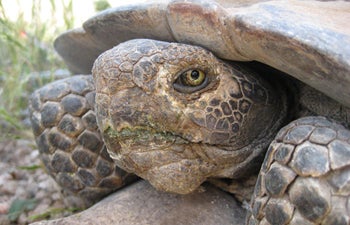Emerging From Their Shells
The Mojave Desert tortoise can withstand as little as two inches of rain per year and temperatures in excess of 140 degrees, but human activity in their habitat has them listed as threatened under the Endangered Species Act. Enter USC Dornsife graduate student Michael Tuma, who wants to ensure that tortoises have the space they need.
Tuma, a doctoral candidate in integrative and evolutionary biology, combines his knowledge of tortoise science with customized computer software to predict where tortoises reside — and what will happen if they’re disturbed.
Mojave Desert tortoises range through California, Utah, Arizona and Nevada. As humans develop the deserts, the resulting cattle fields, solar power plants and other buildings encroach on tortoises. While tortoises’ exact numbers are uncertain, experts estimate some populations have declined by 90 percent or more. As part of his work at SWCA Environmental Consultants in Pasadena, Calif., Tuma helps clients minimize harm to tortoises as they develop the land.
Unfortunately, it isn’t always easy to predict where tortoises can be found. For example, when BrightSource Energy, Inc. selected a site in the Mojave Desert for a new solar plant, initial surveys identified 17 tortoises in the area. But that count was taken during dry periods when the tortoises were hiding underground. During construction, many more tortoises were discovered. BrightSource had to halt construction at part of the site when the U.S. Bureau of Land Management (BLM) ordered the company to relocate the tortoises, a move that made national news.
The BLM has frequently found itself in this position — reacting to tortoise populations as they’re discovered, rather than knowing where they are before development. In 2008, the bureau invited scientists to apply for a project to predict how tortoises might respond to habitat invasions like solar development. Tuma won the job, developing a computer model of tortoise populations.
Tuma collected data from satellite maps and photos, weather records and other sources to understand two tortoise habitats: the Superior-Cronese Desert habitat near Barstow, Calif., and a region including Gold Butte and the Pakoon Basin in Arizona. He also spent a year tracking tortoises in the field.

While tortoises’ exact numbers are uncertain, experts estimate some populations have declined by 90 percent or more. Photo by Michael Tuma.
The resulting map showed areas of high tortoise density, as well as regions unlikely to contain tortoises. Using this data, Tuma could figure out the “rules” that make up where tortoises travel. Then he was able to predict how those tortoise populations would change if the situation changed; for example, if a solar plant or cattle ranch moved in.
Tuma’s computer model also allows him to simulate how tortoises may respond to various events, such as degraded habitats or predators attracted by humans’ trash.
“It’s essentially a big calculator,” he said of his model.
From these simulations, he can predict how to conserve tortoises. “It’s really important to protect large areas of habitat,” he said. That means solar energy providers and others should probably build close to towns, not on untouched lands.
If developers must use tortoise-populated land, then transporting the tortoises elsewhere could be a solution. However, Tuma noted, transporting cannot be done during drought years. Transplanted tortoises are vulnerable before they find burrows, and predators go after them when water and food are scarce.
Tuma’s love for a different kind of animal goes way back to when he was 5 and his father brought home a toad. He now has about 30 turtles and tortoises, 10 snakes and a few lizards.
“I’m attracted to critters that are different in form than us.” He said. “There’s something very magical about tortoises. They look old and ancient in their faces.”
Mojave Desert Tortoise Tidbits
Scientific name: Gopherus agassizii.
Habitat: Mojave tortoises are the only tortoises that can survive in deserts receiving as little as 50 millimeters of rain each year. Tortoises keep cool in underground burrows.
Size: About a foot long; males are bigger than females.
Life span: They can live to 80 years or so.
Diet: Grass, leaves and flowers. They mainly eat fresh wildflowers, which means they only feast in spring.
Early eating habits: Like many plant-munching reptiles, baby tortoises eat the feces of adults to acquire the intestinal bacteria they need to digest vegetation.
Water management: Tortoises seek out low places where water collects and often return to the same spot when rain is on the horizon. The spot might be a hollow in a rock or, in one instance, a crushed Coke can where a hatchling was seen waiting for rain.
Mojave tortoises get to drink only when it showers and can survive for a year or more without a sip of water. They can hold about a quart of water in reserve in their large bladders, similar to how camels store water in their humps, and tortoises don’t expel the water until their next drink. Over time, biological waste products build up in their water reservoir. The concentrated waste would kill a human, but tortoises can endure.
If you see a tortoise, don’t pick it up — it might empty its bladder in defense and be unable to survive until the next rainfall.
Fighting: Males fight over access to females’ territory. They use an extension of their lower shell, called a gular horn, to flip each other over.